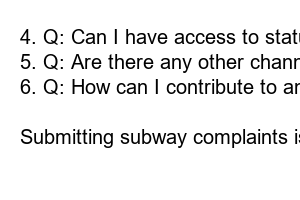지하철 민원 넣는 법
Title: Convenient and Hassle-Free: Submitting Subway Complaints Made Easy
Subheadings:
1. Introduction: Speaking Up for Improved Subway Experience
2. How to Submit a Subway Complaint: Step-by-Step Guide
3. Benefits of Directly Addressing Subway Complaints
4. Steps Taken by Authorities to Address Subway Complaints
5. Common Subway Complaints and their Solutions
6. Frequently Asked Questions (FAQs) About Submitting Subway Complaints
7. In Conclusion: Empowering Commuters to Drive Positive Change
Introduction: Speaking Up for Improved Subway Experience
When riding the subway, everyone expects a smooth and comfortable journey. From unexpected delays to overcrowding, subway systems are not immune to occasional hiccups. However, staying silent about recurring issues only perpetuates the problem. By actively submitting your subway complaints, you can play a vital role in shaping a better commuting experience for everyone.
How to Submit a Subway Complaint: Step-by-Step Guide
1. Identify the correct authority: Determine the appropriate body to address your complaint, such as the local transit authority or the subway operator. Check their website or helpline for the relevant channels to submit complaints.
2. Gather essential details: Before reaching out, note down important information, such as the date, time, and location of the incident, the train or station involved, and any identifying details about the issue or employees involved.
3. Select the suitable contact method: Subway authorities typically provide different options for submitting complaints, including online forms, dedicated email addresses, or phone hotlines. Choose the method that suits you best.
4. Be precise and concise: Clearly describe the problem, providing relevant details without unnecessary verbosity. Stick to the key points, avoiding vague or lengthy narratives.
5. Attach evidence if available: If you captured photos, videos, or any supporting documentation, attach them to your complaint. Visual evidence can significantly strengthen your case.
6. Follow up if necessary: Maintain a record of your complaint submission and, if needed, reach out for updates. This ensures that your concern receives the attention it deserves.
Benefits of Directly Addressing Subway Complaints
By submitting your subway complaints directly to the relevant authorities, you actively participate in creating positive change. Here are some key benefits:
– Improved subway services and infrastructure
– Enhanced safety measures for commuters
– Timely resolution of recurring issues
– Feedback-driven improvements based on passenger experiences
Steps Taken by Authorities to Address Subway Complaints
Subway authorities recognize the importance of addressing commuter concerns. To demonstrate their commitment and ensure your voice is heard, they have implemented various measures, including:
– Dedicated complaint handling teams
– Streamlined complaint management systems
– Real-time monitoring of complaints for swift action
– Regular analysis to identify patterns and implement systemic changes
Common Subway Complaints and their Solutions
1. Overcrowding: Authorities are working on increasing train frequency and introducing additional rush-hour services to address overcrowding.
2. Delays: Ongoing infrastructure upgrades and advanced scheduling systems are being implemented to reduce delays and improve service reliability.
3. Maintenance and cleanliness: Regular cleaning schedules, increased maintenance efforts, and awareness campaigns are being undertaken to ensure cleaner stations and trains.
4. Communication gaps: Authorities are investing in better passenger information systems, such as digital signage and real-time updates, to bridge communication gaps.
5. Security concerns: Enhanced surveillance, station personnel deployment, and collaboration with law enforcement agencies help enhance security measures.
Frequently Asked Questions (FAQs) About Submitting Subway Complaints
1. Q: Can I submit a complaint anonymously?
A: Yes, most subway authorities allow anonymous complaints to protect your identity.
2. Q: How long does it take to receive a response to my complaint?
A: Response times may vary, but authorities aim to acknowledge complaints within a specific timeframe, often within a week or two.
3. Q: What if my complaint is not addressed adequately?
A: If you feel your concerns are not adequately resolved, escalate the issue to higher authorities or regulatory bodies overseeing subway operations.
4. Q: Can I have access to status updates on actions taken in response to my complaint?
A: Many subway authorities now provide means to track the progress of your complaint through online portals or designated helplines.
5. Q: Are there any other channels to express subway-related concerns?
A: Alongside official complaint systems, social media platforms and online forums offer spaces to voice your concerns and engage with others.
6. Q: How can I contribute to an overall better subway experience?
A: Apart from submitting complaints, staying updated with service alerts, abiding by the system rules, and actively participating in surveys or feedback programs can help in driving positive change.
In Conclusion: Empowering Commuters to Drive Positive Change
Submitting subway complaints is a straightforward and impactful way to voice your concerns and contribute to an improved commuting experience. By following the outlined steps, taking advantage of available channels, and staying informed, you can play an active role in shaping the future of your local subway system. Let’s work together to create more efficient, safe, and comfortable journeys for all.

